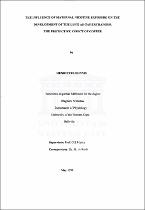| dc.description.abstract | The influence of tobacco smoking on the developing fetus is well reported. Maternal nicotine exposure during pregnancy and lactation interferes with fetal and neonatal lung growth and development, rendering the lungs more susceptible to damage and disease. interference with the normal developmental processes at any stage may compromise the gas exchange function of the lungs. Maternal nicotine exposure during gestation and lactation causes a decrease in the elastic tissue content of the lturgs, which may lead to the formation of emphysema-like lesions. Elastic tissue is catalysed by lysyl oxidase, an extracellular, copper dependent en4rmq from its soluble to its insoluble state. It is suggested that lesions occur in lturgs exposed to nicotine because of a decrease in lung copper content, which will, in turn, cause decreased lysyl oxidase activity. The aim of this study was thus to determine and quantify the effects of maternal nicotine exposure on the development of the fetal and neonatal rat lung as a gas exchanger and to establish whether copper supplementation will protect the lungs against these adverse effects of maternal nicotine exposure. The pregnant rats were divided into four experimental groups. One group received nicotine (lmdkg body weight/day) subcutaneously. Another received copper (lmg/kg body weighVday), while a third group received nicotine (lmglkg body weight/day) in addition to copper (lmg/kg body weighUday). Control rats received sterile saline. These subcutaneous injections were given throughout gestation and lactation. The results obtained showed that maternal nicotine exposure suppresses alveolarization in the fetal and neonatal lung. The lungs of the offspring exposed to nicotine during gestation and lactation have a reduced radial alveolar count, and a decreased alveolar number. All this points to a reduced internal surface area available for gas exchange. Copper supplementation during gestation and lactation prevents the adverse effects of maternal nicotine exposure on development of the lungs of the offspring. Therefore, the lungs of the copper supplemented animals can develop to its full potential as gas exchangers | en_US |

